
Blaenau Ffestiniog is a town in Gwynedd, Wales. Once a slate mining centre in historic Merionethshire, it now relies much on tourists, drawn for instance to the Ffestiniog Railway and Llechwedd Slate Caverns. It reached a population of 12,000 at the peak development of the slate industry, but fell with the decline in demand for slate. The population of the community, including the nearby village Llan Ffestiniog, was 4,875 at the 2011 census: the fourth most populous in Gwynedd after Bangor, Caernarfon and Llandeiniolen. The population not including Llan is now only about 4,000.

Aberllefenni quarry is the collective name of three slate quarries, Foel Grochan, Hen Gloddfa and Ceunant Ddu, located in Cwm Hengae, just to the west of Aberllefenni, Gwynedd, North Wales. It was the longest continually operated slate mine in the world until its closure in 2003. Foel Grochan is the quarry on the north side of the valley, facing Ceunant Ddu and Hen Gloddfa on the south; all three were worked as a single concern throughout their history. Rock was mainly extracted underground, though all three quarries had open pits as well.

The Penrhyn quarry is a slate quarry located near Bethesda, North Wales. At the end of the nineteenth century it was the world's largest slate quarry; the main pit is nearly 1 mile (1.6 km) long and 1,200 feet deep, and it was worked by nearly 3,000 quarrymen. It has since been superseded in size by slate quarries in China, Spain and the USA. Penrhyn is still Britain's largest slate quarry but its workforce is now nearer 200.
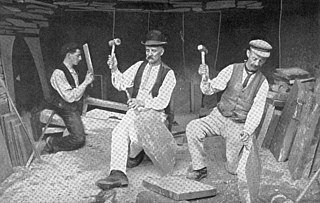
The existence of a slate industry in Wales is attested since the Roman period, when slate was used to roof the fort at Segontium, now Caernarfon. The slate industry grew slowly until the early 18th century, then rapidly during the Industrial Revolution in Wales until the late 19th century, at which time the most important slate producing areas were in northwest Wales. These sites included the Penrhyn Quarry near Bethesda, the Dinorwic Quarry near Llanberis, the Nantlle Valley quarries, and Blaenau Ffestiniog, where the slate was mined rather than quarried. Penrhyn and Dinorwig were the two largest slate quarries in the world, and the Oakeley mine at Blaenau Ffestiniog was the largest slate mine in the world. Slate is mainly used for roofing, but is also produced as thicker slab for a variety of uses including flooring, worktops and headstones.

The Hendre-Ddu Tramway was a 1 ft 11 in narrow gauge industrial railway built in 1874 in Mid-Wales to connect the Hendre-Ddu slate quarry to Aberangell station on the Mawddwy Railway. It consisted of a main line 3+1⁄2 miles (5.6 km) long and several branch lines and spurs serving other quarries, local farms and the timber industry.

The Honister Slate Mine in Cumbria is the last working slate mine in England. Quarrying for Westmorland green slate has been taking place in the area since the late 17th century. Apart from the mining it is also a popular tourist attraction in the Lake District National Park.
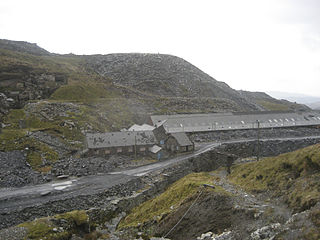
Maenofferen quarry is a major slate quarry in the town of Blaenau Ffestiniog, north Wales and one of the major users of the Ffestiniog Railway. It continues to produce crushed slate on a limited scale under the ownership of the nearby Llechwedd quarry.

Mining in Wales provided a significant source of income to the economy of Wales throughout the nineteenth century and early to mid twentieth century. It was key to the Industrial Revolution in Wales, and to the whole of Great Britain.

Croesor quarry is a large underground slate mine in North Wales which was served by Croesor Tramway. Small scale quarrying began in the 1846, and by 1861, there were two companies in operation. They amalgamated in 1865, a year after the quarry was connected to the newly opened Croesor Tramway. Much money was invested in development work, but volumes of useful slate produced were small, amounting to just 226 tons in 1868. Access to the underground workings was by a single adit, and the surface mill was powered by two water wheels. A change of ownership in 1875 did little to improve the profitability of the quarry, and it closed in 1878 or 1882.

Rhosydd quarry was a slate quarry in the Moelwyn mountains, northeast of Porthmadog in North Wales.

Oakeley quarry is a slate quarry in the town of Blaenau Ffestiniog, north Wales. It was the largest underground slate mine in the world, and had 26 floors spanning a vertical height of nearly 1,500 feet (460 m).

Rhiwbach quarry was a slate quarry located to the east of Blaenau Ffestiniog in North Wales. The quarry was a remote site; it was nearly 4 miles (6.4 km) to north-east of Duffws, the Festiniog Railway's terminus in Blaenau Ffestiniog. It was the connected to the Ffestiniog Railway by the Rhiwbach Tramway. Commercial operation began around 1812, and it finally closed in 1952. It was the last Welsh slate quarry where workers lived in barracks on the site. 'Rhiwbach' is Welsh for 'Little Hill'.

Cwmorthin quarry was a slate quarry west of the village of Tanygrisiau, north Wales. Quarrying on the site started in 1810. In 1860 it was connected to the Ffestiniog Railway. In 1900 it was acquired by the nearby Oakeley quarry and the two were connected underground. In 1970 it closed along with Oakeley. There was small-scale working in the 1980s and 1990s, and the mine finally closed in 1997.
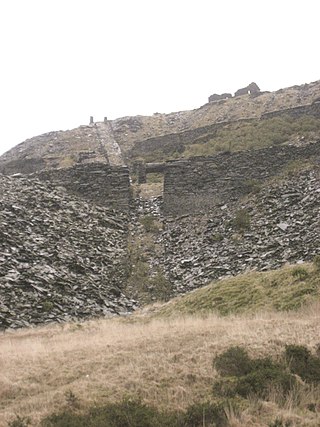
Votty & Bowydd quarry is a major slate quarry in the town of Blaenau Ffestiniog, North Wales. It was one of the major users of the Ffestiniog Railway. It opened in 1870 In the quarry's peak years around 1900, the quarry produced around 17,000 tons-per-annum of slate, employing 500 men. It continues to produce crushed slate on a limited scale under the ownership of the nearby Llechwedd quarry.
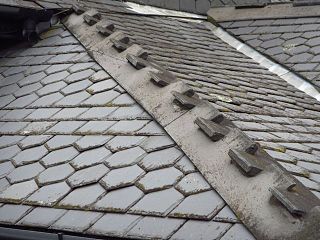
Parc Quarry was a compact underground slate quarry in the Croesor Valley, Gwynedd, North Wales. It was connected to the Croesor Tramway, which ran through the valley. The quarry concentrated on producing specialist slate products, rather than roofing slates, and was managed for much of the time by the innovator Moses Kellow. It operated for about 50 years, from 1870 to 1920.

The natural resources of Wales have contributed substantially to the economic wealth of the United Kingdom from pre-Roman times to the present. Wales has a complex and varied geology with a wealth of natural minerals. Although Wales has been strongly associated with the coal industry, it has also been the world's leading supplier of slate and of copper at different times. The country lies along the western side of Great Britain and is buffeted by the prevailing South-Westerly trade winds which bring year round rain and wind but also maintain an equable temperate climate. The combination of climate and physical geography and geology have given rise to many different types of landscape and biomes rich in species variety.
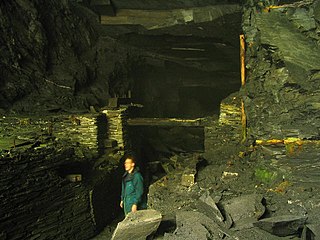
The Cambrian quarry was a slate quarry, located to the west of Glyn Ceiriog in Denbighshire, North Wales. There was some small-scale extraction of slate from the 17th century, but commercial extraction began in 1857, and the scale of operation increased from 1873, when the Glyn Valley Tramway opened, providing an easier route to market for the output of the quarry. Production after 1938 was on a reduced scale, and the quarry closed in the winter of 1946/47, mainly due to a lack of workers.
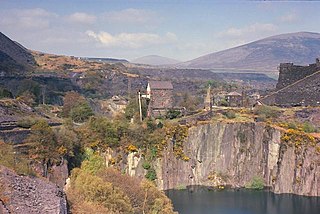
The Slate Industry in the Nantlle Valley was the major industry of the area. The Nantlle Valley is the site of oldest slate quarry in Wales at Cilgwyn, and during the nineteenth and twentieth centuries it was a major centre of the Slate industry in Wales. The quarries of the area are a World Heritage Site.
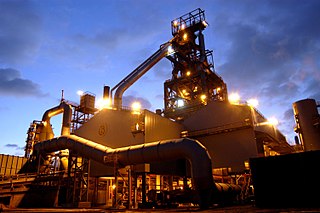
The manufacturing sector in Wales was historically centred on the mining industry, with slate, coal, tinplate and steel being important industries. Today, while traditional industries remain in smaller quantities, manufacturing in Wales is increasingly specialised and diverse, including parts of the automotive, aerospace, medical and technological industries.
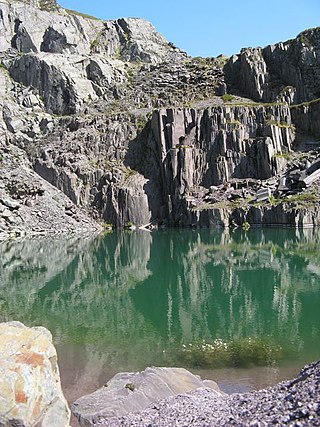
Alexandra quarry was a slate quarry in North Wales, on the slopes of Moel Tryfan in north Gwynedd. It was part of one of the major slate quarrying regions of Wales, centred on the Nantlle Valley during the 19th and 20th centuries. Output increased when a connection to the North Wales Narrow Gauge Railways branch to Bryngwyn was created. It closed in the late 1930s, but was subsequently amalgamated with the Moel Tryfan quarry, and production continued until the 1960s.






















